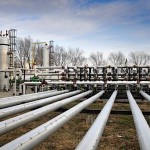 Natural gas increased on Monday for a second time out of tree trading sessions as forecasts project possible colder weather later this month.
Natural gas increased on Monday for a second time out of tree trading sessions as forecasts project possible colder weather later this month.
Natural gas for delivery in January climbed 1.78% to $3.659 per million British thermal units by 9:53 GMT. Prices held in a daily range between $3.675 and $3.608. The energy source dropped 5.44% on Monday to $3.595, but not before dropping to $3.585, its lowest since November 20, 2013.
According to NatGasWeather.com, natural gas demand in the US over the next seven days will be moderate, compared to normal, with a neutral, but potentially slightly colder trend for the December 16 – December 22 period.
A strong Nor’easter type weather system will become stronger very fast today as it flows alongside the Northeast coast, bringing waves of heavy rain, snow and strong winds.
The cold front will move into the eastern US, pushing temperatures 10 degrees lower than normal, with sub-freezing readings in the southeastern US. However, the Southwest and central US will enjoy significantly warmer than usual temperatures as high pressure dominates.
On Thursday a strong Pacific jet stream is expected to arrive in the western US and push back colder Canadian air out of US territory, enabling the majority of the US to warm up to above average temperatures from late this week through next week.
Waves of moist Pacific weather systems will track across the US every few days with periods of heavy rains and snow through December 21st. However, each system will fail to release the trapped colder northern Canadian air and thus allow temperatures to reach above normal levels over most regions.
Lows in central and eastern US may drop to around 20s every now and then, which is not so scary for mid-December. However, colder temperatures may hit the US shortly after December 21st as Canadian air attempts to push into the country.
Temperatures
According to AccuWeather.com, temperatures in New York on December 9th will range between 33 and 41 degrees, compared to the average of 34-45, before reaching the above-seasonal 36-48 on December 15th. Chicago will see readings of seasonal 24-34 degrees on December 10th, before overtaking normal temperatures by 15 to reach 50 degrees on December 14th.
Down South, the high in Texas City on December 9th will be 65 degrees, in line with the usual, before slightly increasing to 57-71 degrees on December 14th. On the West Coast, today’s temperature in Los Angeles will peak at 76 degrees, 8 above normal, before readings moderate to seasonal 66 degrees on December 13th.
Supplies
The Energy Information Administration reported on Thursday that US natural gas inventories slid by 22 billion cubic feet in the week ended November 28th, below analysts’ projections ranging between 30 and 50 billion cubic feet. It was also beneath the five-year average gain of 50 bcf and last year’s decline of 141 bcf during the comparable period.
Total gas held in US storage hubs stood at 3.410 trillion cubic feet as of November 28th, narrowing its deficit to the five-year average of 3.782 trillion to 9.8% from 10.4% during the preceding seven days. Stockpiles were also 6.2% below the year-ago level of 3.637 trillion cubic feet.
The East Region saw a net withdrawal of 34 bcf to 1.830 trillion and was 9.1% below the five-year average, while inventories at the West Region rose by 1 bcf to 478 bcf and were 8.4% behind average levels. Stockpiles in the Producing Region rose by 11 bcf to 1.102 trillion, trailing the average by 11.6%.
Pivot Points
According to Binary Tribune’s daily analysis, January natural gas futures’ central pivot point stands at $3.655. In case the contract penetrates the first resistance level at $3.725 per million British thermal units, it will encounter next resistance at $3.855. If breached, upside movement may attempt to advance to $3.925 per mBtu.
If the energy source drops below its first support level at $3.525 per mBtu, it will next see support at $3.455. If the second key support zone is breached, the power-station fuel’s downward movement may extend to $3.325 per mBtu.





